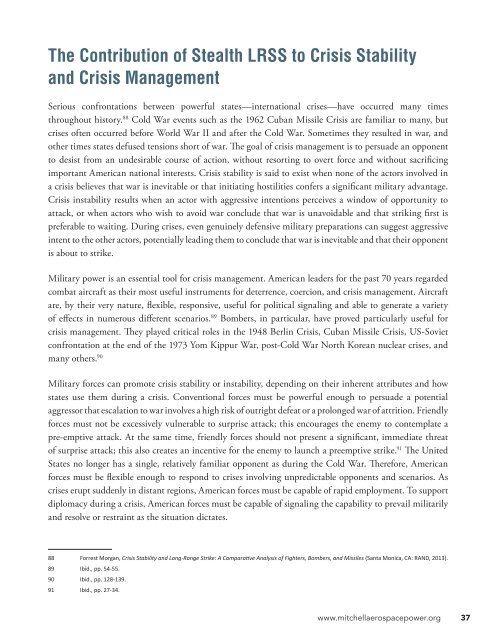You also want an ePaper? Increase the reach of your titles
YUMPU automatically turns print PDFs into web optimized ePapers that Google loves.
The Contribution of Stealth LRSS to Crisis Stability<br />
and Crisis Management<br />
Serious confrontations between powerful states—international crises—have occurred many times<br />
throughout history. 88 Cold War events such as the 1962 Cuban Missile Crisis are familiar to many, but<br />
crises often occurred before World War II and after the Cold War. Sometimes they resulted in war, and<br />
other times states defused tensions short of war. The goal of crisis management is to persuade an opponent<br />
to desist from an undesirable course of action, without resorting to overt force and without sacrificing<br />
important American national interests. Crisis stability is said to exist when none of the actors involved in<br />
a crisis believes that war is inevitable or that initiating hostilities confers a significant military advantage.<br />
Crisis instability results when an actor with aggressive intentions perceives a window of opportunity to<br />
attack, or when actors who wish to avoid war conclude that war is unavoidable and that striking first is<br />
preferable to waiting. During crises, even genuinely defensive military preparations can suggest aggressive<br />
intent to the other actors, potentially leading them to conclude that war is inevitable and that their opponent<br />
is about to strike.<br />
Military power is an essential tool for crisis management. American leaders for the past 70 years regarded<br />
combat aircraft as their most useful instruments for deterrence, coercion, and crisis management. Aircraft<br />
are, by their very nature, flexible, responsive, useful for political signaling and able to generate a variety<br />
of effects in numerous different scenarios. 89 Bombers, in particular, have proved particularly useful for<br />
crisis management. They played critical roles in the 1948 Berlin Crisis, Cuban Missile Crisis, US-Soviet<br />
confrontation at the end of the 1973 Yom Kippur War, post-Cold War North Korean nuclear crises, and<br />
many others. 90<br />
Military forces can promote crisis stability or instability, depending on their inherent attributes and how<br />
states use them during a crisis. Conventional forces must be powerful enough to persuade a potential<br />
aggressor that escalation to war involves a high risk of outright defeat or a prolonged war of attrition. Friendly<br />
forces must not be excessively vulnerable to surprise attack; this encourages the enemy to contemplate a<br />
pre-emptive attack. At the same time, friendly forces should not present a significant, immediate threat<br />
of surprise attack; this also creates an incentive for the enemy to launch a preemptive strike. 91 The United<br />
States no longer has a single, relatively familiar opponent as during the Cold War. Therefore, American<br />
forces must be flexible enough to respond to crises involving unpredictable opponents and scenarios. As<br />
crises erupt suddenly in distant regions, American forces must be capable of rapid employment. To support<br />
diplomacy during a crisis, American forces must be capable of signaling the capability to prevail militarily<br />
and resolve or restraint as the situation dictates.<br />
88 Forrest Morgan, Crisis Stability and Long-Range Strike: A Comparative Analysis of Fighters, Bombers, and Missiles (Santa Monica, CA: RAND, 2013).<br />
89 Ibid., pp. 54-55.<br />
90 Ibid., pp. 128-139.<br />
91 Ibid., pp. 27-34.<br />
www.mitchellaerospacepower.org 37


